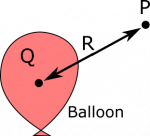Example: Electric Potential from a Positively Charged Balloon
Suppose we have a positively charged balloon with total charge $Q=5.0\cdot 10^{-9} \text{ C}$. What is the electric potential (also called voltage) at a point $P$, which is a distance $R=50 \text{ cm}$ from the center of the balloon?
Facts
- The balloon has total charge $Q=5.0\cdot 10^{-9} \text{ C}$.
- The point $P$ is a distance $R=50 \text{ cm}$ away from the center of the balloon.
- The electric potential due to a point charge can be written as $$V = \frac{1}{4\pi\epsilon_0}\frac{q}{r},$$ where $q$ represents the charge and $r$ is the distance.
Representations
Assumption
We assume $P$ lies outside of the balloon. We make this assumption because it was not specified, but this seems to make more sense than $P$ being inside the balloon. This also helps us draw the representation below, which can be used to bolster our approximation later on of the balloon as a point charge.
Goal
- Find the electric potential at $P$.
Solution
Approximation
We approximate the balloon as a point charge. We do this because we have the tools to find the electric potential from a point charge. This seems like a reasonable approximation because the balloon is not too spread out, and we are interested in points outside the balloon. so the balloon might “look” like a point charge from the perspective of an observation location that is little far away.
Assumption
The electric potential infinitely far away from the balloon is $0 \text{ V}$. Read here for why this is important.
The electric potential at $P$ is given by \begin{align*} V &= \frac{1}{4\pi\epsilon_0}\frac{q}{r} \\ &= \frac{1}{4\pi\cdot 8.85\cdot 10^{-12} \frac{\text{C}}{\text{Vm}}}\frac{5\cdot 10^{-9} \text{ C}}{0.5 \text{ m}} \\ &= 90 \text{ V} \end{align*}
